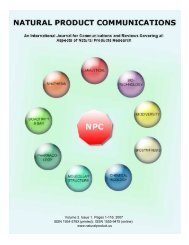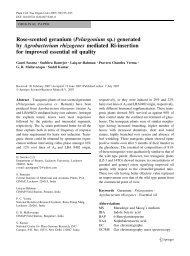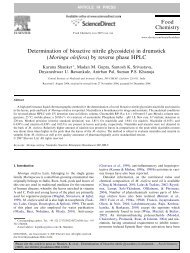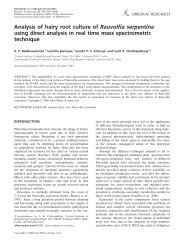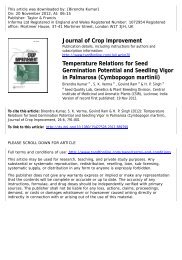Rai A, Smitha SS, Singh AK, Shanker K, Nagegowda ... - CIMAP Staff
Rai A, Smitha SS, Singh AK, Shanker K, Nagegowda ... - CIMAP Staff
Rai A, Smitha SS, Singh AK, Shanker K, Nagegowda ... - CIMAP Staff
- No tags were found...
Create successful ePaper yourself
Turn your PDF publications into a flip-book with our unique Google optimized e-Paper software.
Page 14 of 20<strong>Rai</strong> et al. • C. roseus Geranyl Diphosphate Synthasesinto IDS-b clade that includes three angiosperm GPPSs fromArabidopsis (AtGPPS), L. esculentum (LeGPS), and Q. rubur(QrIDS1), and one gymnosperm GPPS from P. abies (PaIDS3),which produced FPP and or GGPP in addition to GPP (Bouvieret al., 2000; van Schie et al., 2007; Schmidt and Gershenzon,2008). AtGPPS was recently shown to be a PPPS in contrast tothe earlier report (Hsieh et al., 2011). However, CrGPPS fromthe same IDS-b clade produced only GPP and showed mitochondriallocalization (Figure 10 and Figure 11). Interestingly,prediction analyses revealed that, like CrGPPS, the GPPSs ofA. grandis (AgGPPS1) of clade-IDSa2 and all proteins of cladeIDS-b seem to be localized to mitochondria (SupplementalTable 1). This suggested the possible role of IDS-a2 and IDS-bclade of enzymes in associated terpene biosynthesis pathwaysin plant cell. The IDS-c1 is represented by inactive <strong>SS</strong>U-I class ofheteromoeric GPPS, whereas an unusual homomeric GPPS fromorchid (P. bellina) lacking a DD(X) 2–4 D motif with close relatednessto <strong>SS</strong>Us has been clustered as IDS-c2 clade (Hsiao et al.,2008). The IDS-c3 clade contains a unique A. thaliana protein(At<strong>SS</strong>U-II) with two CxxxC motifs and a FARM motif but lackinga SARM motif (Wang and Dixon, 2009) (Figure 11). At<strong>SS</strong>U-IIshowed no activity but modified the chain length specificity ofAtGGPPS11 and HlGPPS.LSU, which is similar to the functionof other characterized <strong>SS</strong>Us (Wang and Dixon, 2009). Our phylogeneticanalysis demonstrated that IDS-c clade, consistingof members of IDS-c1, IDS-c2, and IDS-c3, could have evolvedfrom a common ancestor in which a homodimeric GPPS fallinginto IDS-c2 clade is active whereas <strong>SS</strong>U-I (IDS-c1) and <strong>SS</strong>U-II (IDSc3)are catalytically inactive. This could be due to the exceptionallyhigh speciation rate of orchids (Tsai and Chen, 2006)that would have altered the inactive <strong>SS</strong>U by modification ofa few amino acids, resulting in the required GPPS activity. Thisis evident with the presence of an alternate EAEVE motif ofPbGPPS, which is located in the equivalent position of SARM(Hsiao et al., 2008). The significance of presence of <strong>SS</strong>U-II inplants is currently unknown but a systematic characterizationof this class in different plants should provide the evidence forits role in plant metabolism.ConclusionsThe study of complex MIA biosynthesis and its regulationremains a great challenge in plant secondary metabolism. Thefunctional characterization of CrGPPSs in this study providedinsights into the formation of GPP in C. roseus. The CrGPPS.LSUmight have evolved to produce both GPP and GGPP in C. roseusto maintain relative amounts of precursors for both primary aswell as secondary metabolism. The plastid targeted CrGPPS.<strong>SS</strong>Uand CrGPPS.LSU form active heteromeric GPPS to catalyze efficientproduction of GPP in vivo and provide better availability ofthis substrate to geraniol synthase, whereas homomeric CrGPPSmight be involved in mitochondrial isoprenoid biosynthesisfor the production of ubiquinones. The temporal and spatialexpression analysis of CrGPPS genes and transient overexpressionimplies that CrGPPS.<strong>SS</strong>U could function in coordinatedredirection of the metabolic flux, thereby acting as a primaryregulator to a certain extent in MIA biosynthesis. Takentogether, our results suggest that, under normal conditions, abasal level of the GPP pool is provided by both CrGPPS.LSU (abifunctional G(G)PPS) and heteromeric CrGPPS.LSU/CrGPPS.<strong>SS</strong>Utowards MIA formation in C. roseus. However, under biotic/abioticstress, the induced expression of <strong>SS</strong>U could result in an elevatedlevel of GPPS activity by LSU and <strong>SS</strong>U interaction, therebyincreasing the GPP pool towards MIA biosynthesis.METHODSPlant Material and MeJA TreatmentC. roseus cv. Dhawal (National Gene Bank, CSIR–<strong>CIMAP</strong>, India)plants were grown under normal greenhouse conditions.For MeJA treatments, 95% pure MeJA (Sigma-Aldrich) wasadded to a 5% (w/v) sucrose solution to a final concentrationof 200 mM. Excised leaves of the third developmental stagewere placed in a Petri plate containing the MeJA/sucrose orDMSO (the MeJA solvent) as a control. Samples were collectedat 0, 1, 4, 8, and 12 h, and stored at –80°C until further use.Chemicals and Radiochemicals[1- 3 H]-IPP (1.85 MBq) was purchased from AmericanRadiolabeled Chemicals (www.arcincusa.com). Unlabeled IPP,DMAPP, GPP, and FPP were purchased from Echelon ResearchLaboratories (www.echelon-inc.com). Terpenoid standardsand reagents were purchased from Sigma-Aldrich (www.sigmaaldrich.com)unless otherwise noted.RNA Isolation and cDNA SynthesisAbout 100 mg of tissue was ground in liquid nitrogen andtotal RNA was extracted using a Spectrum TM Plant Total RN<strong>AK</strong>it (Sigma-Aldrich, USA) according to the manufacturer’sinstructions. To amplify the 3′ end of CrGPPS.<strong>SS</strong>U, 3′ RACEcDNA was prepared with 5 µg total RNA using a SuperscriptIII RT Module (Invitrogen). Then, 3′ RACE PCR was carried outusing a GeneRacer TM Kit (Invitrogen) with 3′ RACE cDNA alongwith gene-specific reverse and nested primers and GeneRacer3′ and 3′ nested primers (Supplemental Table 2). The amplifiedfragment was cloned into pJET1.2/ vector and the sequencewas confirmed by nucleotide sequencing. cDNA for amplifyingopen reading frames of CrGPPSs and for real-time PCR analysiswas prepared by using a RevertAid H Minus First StrandcDNA Synthesis Kit (Fermentas International Inc., Canada).For real-time qRT–PCR, the DNA-free total RNA (5 μg) wasused for first-strand cDNA synthesis with Oligo(dT) 18 primersusing RevertAid H Minus Reverse Transcriptase. A linear rangeof cDNA was used for real-time PCR. Real-time qRT–PCR wasperformed in a 96-well plate using the Applied Biosystems7900HT Fast Real-Time PCR System (PE Applied Biosystems,www.appliedbiosystems.com) with SYBR green fluorescentdye using respective forward and reverse primers for eachgene (Supplemental Table 2). Fold change differences in geneDownloaded from http://mplant.oxfordjournals.org/ at Central Inst. Of Medicinal & Aromatic Plants (Cimap) on July 17, 2013




